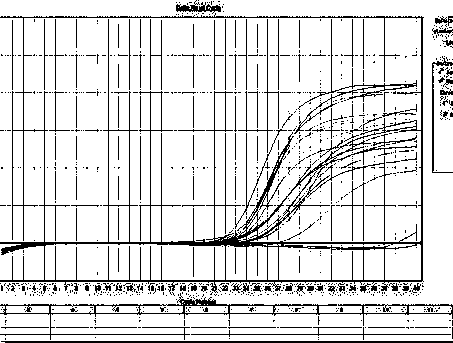Human papilloma virus (24 types) detection (fluorescent PCR method) kit and detection method
A detection method and technique for papilloma, which are applied in the directions of fluorescence/phosphorescence, biochemical equipment and methods, and determination/inspection of microorganisms, to achieve the effect of avoiding the decline of amplification efficiency
- Summary
- Abstract
- Description
- Claims
- Application Information
AI Technical Summary
Problems solved by technology
Method used
Image
Examples
Embodiment 1
[0055] Example 1: Primer probe design
[0056] Studies have shown that the L1 regions of various types of HPV genomes have both certain homology and certain specificity, and degenerate primers can be designed according to the homologous sequences. The present invention detects the primer probe design principle of 24 types of HPV DNA is: the L1 region of HPV genome of each type selects the sequence with high homology to design forward and reverse primers, and designs the probe sequence at the sequence with high specificity, Perform PCR in the same tube while using Taqman probes to detect 24 types of HPV. The template denaturation temperature is 95°C; the primer annealing and extension temperature is 52°C; the number of cycles for the amplification reaction is 35-45.
[0057] Table 1 is the gene bank number of the amplified target sequence
[0058] HPV type Genebank number target sequence position HPV6 probe X00203 6227-6409 HPV11 probe M14119 6220-...
Embodiment 2
[0059] Example 2: Sample Preparation
[0060] In order to quickly and easily prepare HPV DNA templates that can be used for PCR amplification, the present invention uses a non-ionic detergent in conjunction with a high temperature environment to crack the HPV outer membrane protein to release the DNA therein, and uses chelex-100 to remove the metal therein Impurities such as ions that inhibit PCR can be used to improve detection efficiency.
Embodiment 3
[0061] Embodiment 3: system optimization
[0062] In order to simultaneously detect 24 types of HPV in the same reaction tube, the primer probe concentration and reaction system must be optimized to avoid interference between primer probes and the lower extension temperature required for Taqman probe hybridization .
PUM
 Login to View More
Login to View More Abstract
Description
Claims
Application Information
 Login to View More
Login to View More - R&D
- Intellectual Property
- Life Sciences
- Materials
- Tech Scout
- Unparalleled Data Quality
- Higher Quality Content
- 60% Fewer Hallucinations
Browse by: Latest US Patents, China's latest patents, Technical Efficacy Thesaurus, Application Domain, Technology Topic, Popular Technical Reports.
© 2025 PatSnap. All rights reserved.Legal|Privacy policy|Modern Slavery Act Transparency Statement|Sitemap|About US| Contact US: help@patsnap.com


